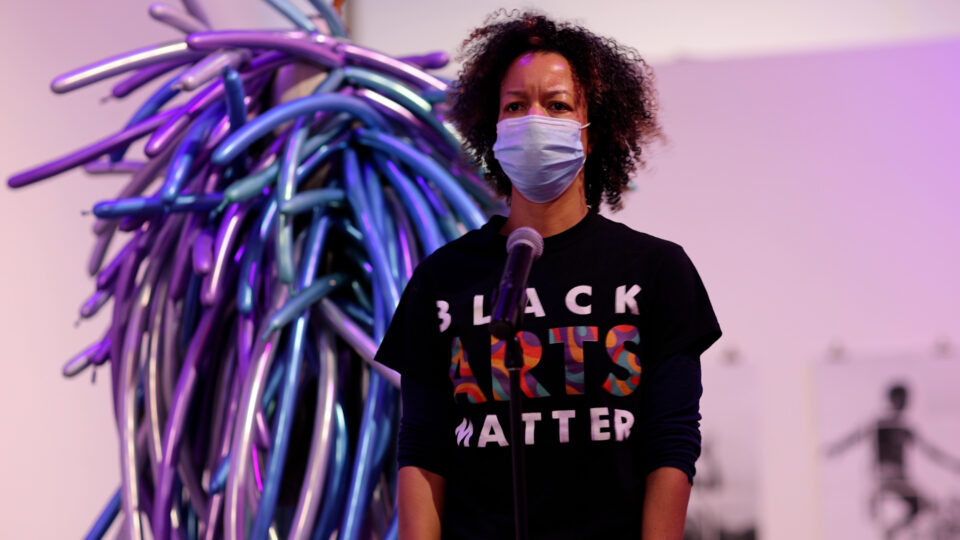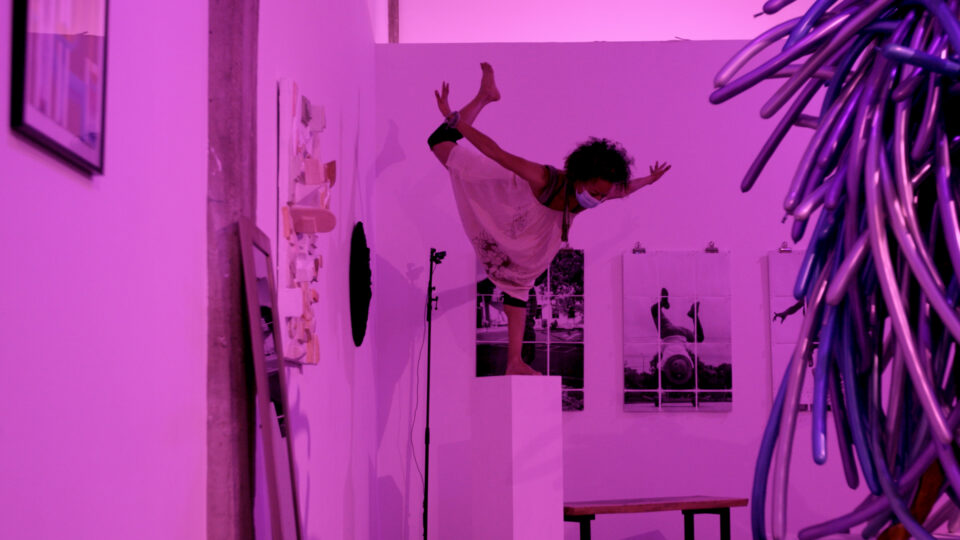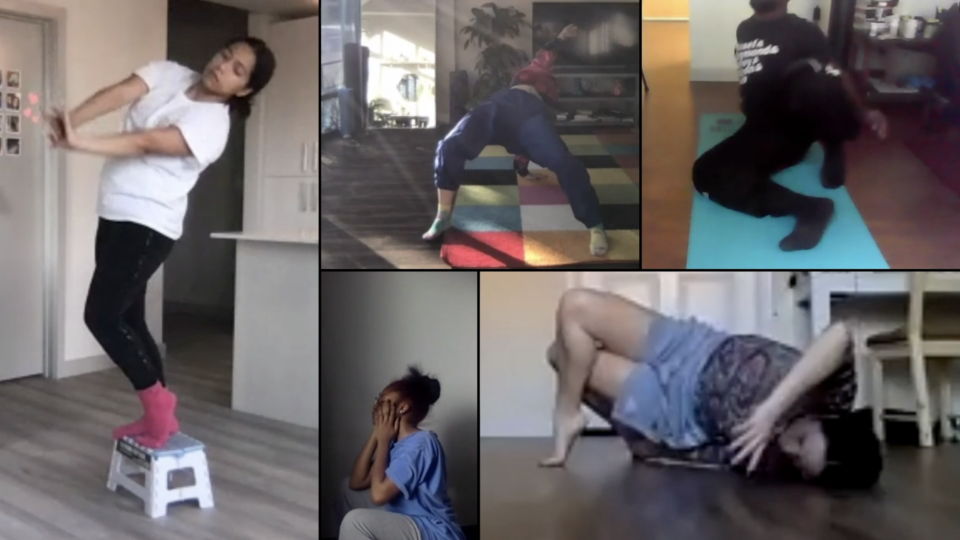Through a pandemic, power outages and remote rehearsals, Gesel Mason has helmed the ship for our upcoming production of burst! This movement-based investigation of identity and community stems from her previous work, specifically Yes, And, which she developed in part through her residency with Texas Performing Arts/Fusebox Festival. Her previous performance at ICOSA Collective, straddling the end of 2020 and the beginning of 2021, was just one of the many springboards for her upcoming production. Now, transferring what she calls a “methodology of undoing” to a group of UT students, this project has grown into a process of discovery and observation; of holding space and acknowledging the messiness of our current moment.
Tell me a little bit about burst!. What are the major themes that are explored in this piece?
The definition of “burst” is to rupture. It’s often seen as an explosion, but it’s a shift.
When we think of burst – you know, you can have a burst of joy, you can burst into tears – and it felt appropriate for this moment where we’re trying to recover from a global pandemic and we’re coming out of a season of political unrest – storming the capital. I feel like we’re in a moment of shift coming into 2021, with folks being excited about the New Year. Spring is coming at some point, so I was just thinking about these moments of transformation. What do we want to hold on to and what do we want to let go of as we move from one type of existence into another?
It’s also thinking about when we say we’re ready to get back to “normal:” 1) was that normal? and 2) what is it that we really want to get back to? So, with the students, asking that question of “What do you want to hold on to? What do you want to let go of as we move forward?” is the theme.

Coming from my other project Yes, And, which centers around the creative ingenuity, expertise and voices of Black women – centering their voices – one of the guiding questions in that project is “Who would you be and what would you do if, as a Black woman, you had nothing to worry about?”
The way that I’m taking that question and bringing it to work with the UT students is “Who would you be and what would you do; how would you be in community with others; what would you make; what would you create if you were the fullest version of yourself? If you could be in the world without fear or repercussion, how would you show up?” I see burst! as a process and a way of transformation. What do you need to sort of work through and get through? What provides the portal to get you to the other side, so that you can show up? What do you have to undo, get rid of, shed so that you can be ready to take on the next step?
Give me a brief look into the process for burst!. How has it evolved in conversation with your other recent projects like Yes, And.
Through my project Yes, And I had the opportunity to be one of four works that were a part of the inaugural Texas Performing Arts (TPA)/Fusebox Festival residency program. It was really great for them to offer that space and time.
As part of that residency, I was able to be in the big rehearsal studio at TPA. It’s huge, and I really was the only person in there. I started bringing stuff from my previous residences and rehearsals: this character “Josephine,” pictures and photos that I had taken and then just stuff that I would be inspired by like costumes and glass jars. I just started bringing all of these things to the space and playing – playing music, improvising, reading, writing, journaling. At the same time, I also conducted interviews with Black women in the Austin Community.
Then, as a culmination of the project, I worked with ICOSA. They had an event called Transmissions that was curated by Tammie Rubin and Terra Goolsby that I applied to and was accepted into. I used that as a way to culminate my residency at TPA. I invited local Black women artists to present their work in the gallery and gave myself this five-hour period of time over New Year’s Eve all the way to January 1, ringing in the New Year for all the time zones in the mainland United States with this idea of trying to metabolize all of 2020 – all the stuff that happened to 2020 – and be clean for 2021.
Now, I’m taking that process and making a version for the students, so music is a part of it, writing is a part of it, journaling is a part of it.
The other thing that was a part of my ICOSA performance was the Yes, And community. Prior to the pandemic the Yes, And community, a tight-knit group of self-identifying Black women, was meeting every other Thursday, and we kept it going because it felt really important during this time. We were just showing up for each other; we would ask, “What do you need? How are you doing? What are you doing well?” We became a resource for each other, and I invited them to sort of be my inner circle for the ICOSA performance.
For this upcoming rendition of burst!, we’re thinking about how the idea of being in community and being in service works when transferred to the students. Connection just feels really important right now. People aren’t necessarily hanging out with their friends and we’ve got first years and freshmen who haven’t even been to the building yet. I think one of the challenges is also trying to figure out how we can create community when we are so remote.
Another piece of burst! is that we’re trying to really honor the process and allow witnesses; we’re not working for an outcome. Usually it’s kind of like “after the process is over” is when audiences are let in, so this is not your typical product. This is the stuff that you wouldn’t see.
I feel like in this pandemic moment it’s important to really open a door or a window into sort of the messiness, not just of learning dance steps but also of trying to be in the world right now. For burst!, there’s improvisation, there’s different prompts that I offer the students like, “The last time you burst into tears or laughter or a moment of joy.” Like I mentioned before, I’m asking, “What do you want to hold on to? What do you want to let go of?” I’m also using words that were generated from the Yes, And community like rant, rave, writhe, release, resist and remember. I share those words with the students and we see what emerges. Then it’s a matter of just trying to put everything together in four weeks.
Did you discover anything during your performance at ICOSA that has influenced the current rendition of burst! that you’re working on?
Well, there are a couple of things. One is the question of how to frame a messy process for an audience that’s used to having things delivered in a perfect package right when they sit down and have paid for their ticket. That’s often how our exchange goes in the theatre. There are ways that I think artists are really good at gauging energy in-person and can present a process where there’s no costumes and audience members feel it and understand it. But I think presenting through a screen also makes audiences expect something. It’s really caused me to think about how I can do that. I don’t have the answer, but I brought on some people to really try to help.

I have a line producer, Kyle Evans, who’s working the back end of the live stream, and he actually works in art, entertainment and television and is an instructor in the Department of Design and Creative Technologies. He does experimental work and is really good at it. I feel like, in this moment as artists, finding the real resources to help us shape over this virtual realm when we are so used to being in person and in physical rehearsals has been amazing. I’m working with Eliot Gray Fisher to do these videos and, since it’s all remote, we’re instructing students on where to put their cameras and lights. So I think a major part of this process is trying to honor that this is just messy right now, and maybe this is the time to shift our expectations. I think one of the things I’m really thinking about is how we can invite the audience into this process in a way that makes them feel connected versus disconnected.
Another, more tangible aspect that carried over from my performance at ICOSA came from the collaboration I had with the visual artists. For that performance, Dawn Okoro came into the studio with me, and she designed this amazing costume. She creates, in addition to a lot of other stuff, wearable art. I didn’t know what she was going to create and she designed this amazing balloon dress. Just being able to interact with her art – with what emerged out of our conversation and her process – was really exciting. It was the last costume I put on during the performance and to be able to get around and squeeze it and move it was really freeing. It felt like the appropriate ending for burst!. Now, knowing how much fun I had with this costume piece, I’m thinking about how to recreate that for the students. We’re planning to have a few of the dancers make their own version of the dress based on Okoro’s designs.
The last thing I’ll say is when I finished burst! at ICOSA, after five hours, I had what Brené Brown calls a “vulnerability hangover” after going through this thing until three in the morning. Since it was a virtual performance, the response is also different; nobody’s gonna call me like, “Oh my God, it was the best performance ever!” because nobody was there, except my mom for like five hours. Viewers could come and go; they could leave or leave it on their TV; they could celebrate with me or they could not. Nobody really saw all of the pieces, but I know how I felt after a process like that. I’m thinking about how to hold that space for 18 students. That sense of community is one of the things I’m trying to bring in that I think is really important. Because I don’t know what people might go through, and how do you hold space for that? I’ve been thinking about that a lot.
What do you hope that audiences will take away after seeing the upcoming iteration of burst!?
You know I really hope that audiences can just be open to the messiness. There’s a lot of personal stories that are being shared and a lot of vulnerability that the dancers are opening themselves up to. I guess, in a way, I hope that also unlocks some vulnerability in the viewer, you know? How is it that you identify with these stories, even if the movement is unfamiliar? It might not look like any dance steps that you’ve ever seen before, and maybe even like, “Is this dance?”

I’m also focusing on this idea of reaching through the screen and finding some sense of connection. If someone does a little bit of their own undoing, that’s what I hope for. If they have to undo a little bit to even just watch this event; if a story happens that makes them think, “Oh wow!”
Additionally, I think that sometimes the stories of young people get dismissed. We’re hearing so much about how students are struggling in school right now. They’re on Zoom for hours and hours and hours trying to make this work. Sometimes you want to put the blame on them, but it’s pretty intense to have your first college experience and basically never leave your dorm room. I feel like I also just want to provide a window into their experiences, and maybe that will allow us to see them differently – to maybe see ourselves differently. Maybe it encourages us to ask the question, “What do I want to hold on to? What do I want to let go of? What isn’t serving me, and how can I be in service to other people? Am I checking in? What do I need? What am I doing well?”
Maybe, by hearing those kinds of ideas and questions and seeing the honesty in which these students are attacking these ideas, maybe it opens up a little vulnerability in ourselves; a little undoing, a little shedding that can allow us to be different. If that’s what we need to do as we move forward.
burst! Conceived and Directed by Gesel Mason
February 25-27, 2021 at 7:30 p.m.
Virtual Performance

